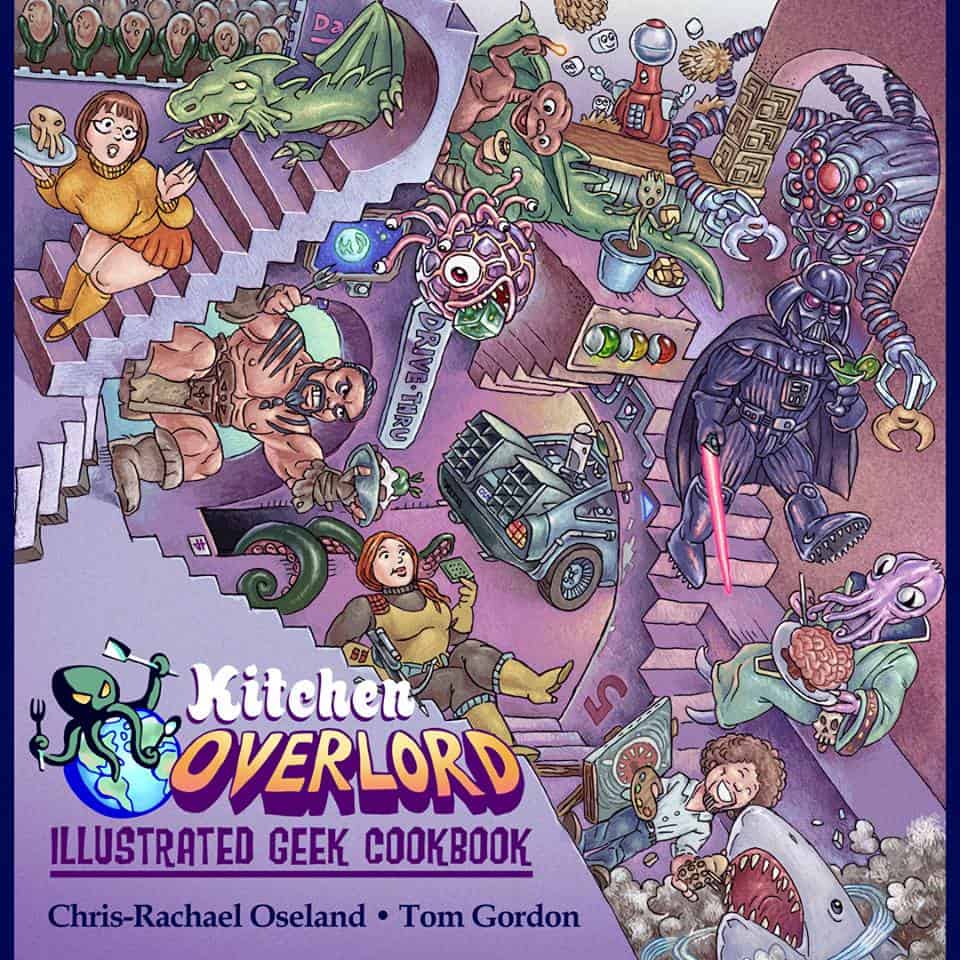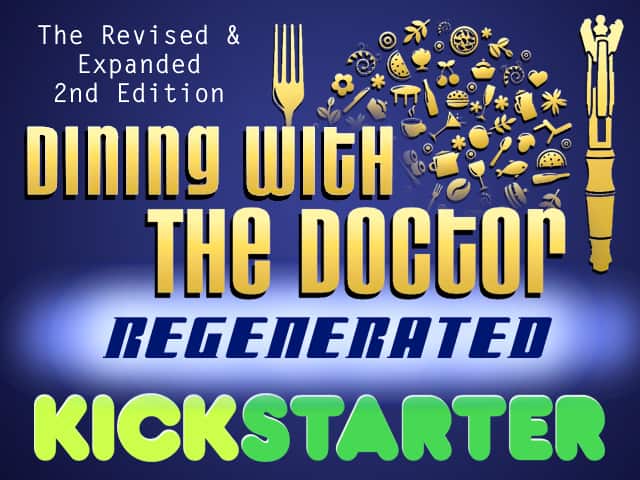I had the good fortune to meet Chris Rachael Oseland through an online women’s writing group. Her Hobbit cookbook had just come out, and she was looking for reviewers. I gladly raised my hand in tribute.
Chris has just launched a Kickstarter to self publish her next book, Dining With the Doctor: the Unauthorized Whovian Cookbook, and she has graciously agreed to answer questions about her process from creating and cultivating your audience to branding basics and how-to market your book.
Part two, by the way, covers a step-by-step guide for self publishing, starting from the spark of an idea and taking you all the way through a finished piece sold on Amazon. But first, let’s get on with part one!
Who is your audience?
I’m still giddily shocked I even HAVE an audience! When I first submitted Dining With the Doctor: the Unauthorized Whovian Cookbook to traditional publishers, the ones who were kind enough to respond gently told me there was no market for a Doctor Who cookbook. At best, maybe I’d sell 300 copies if I self published it. In three years, it sold closer to 30,000 copies, so I’d say their estimates were a little off.
I call my audience “Party Geeks Who Love Crafting.” If they’re in their 20’s, they’re throwing watch parties for season premiers or room parties at SF/F conventions. In their 30-40’s, they’re likely to add in birthday parties for both kids and adults.
In fandom, you don’t gain status through buying things. You gain it by MAKING things. The great thing about making geeky food is you don’t need any special supplies or expensive equipment – you’ve already got everything you need to get started in that special room with the hot box and the cold box and the sharp things. Cooking is often a gateway craft. Gain a little confidence in the kitchen and before long you’re no longer intimidated by the idea of making your own chain mail or adding steampunk mods to a Nerf gun.
Plus, bringing geeky food to a party shows everyone else in the room that you’re One Of Us. If you’ve moved to a new town for work or school, bringing some home made geeky snacks to a watch party meetup is a great way to break the ice and make new friends.
How did you gain the “platform” to get the funding for your Kickstarter?
I spent two years blogging free recipes on Kitchen Overlord a couple times a week plus socially engaging with people as my brand. Most successful Kickstarters that aren’t marketing campaigns for a tech company have a similar story. The folks behind Tephra, a successful Steampunk tabletop role playing game, spent two years attending conventions, shaking hands, letting people play their game for free, and making sure they had a built in audience of people eager for a book before they went to Kickstarter. I hear the same story from just about everyone who earned between $10,000 – 30,000.

It’s also important to go where your audience lives – and do it BEFORE you launch. Preferably months — or a couple years — before. Don’t hang out with social media marketers, and if you’re Kickstarting a book, don’t spend all your time on Goodreads or author forums. Think like a reader. If you’re writing paranormal romance, get active on Supernatural’s Tumblr’s. That’s where your audience lives, and you’ll get a lot more backers (and long term readers) making friends with them than you will professionally engaging with book review sites.
What are your favorite writing tools to keep organized while assembling these cookbooks?
This is where you get me to embarrass myself! I know there are great tools out there — and the Evernote evangelists are determined to convert me — but honestly, I just start a couple folders in My Documents. One is for the book’s text, the other is for photos.
The book text folder ends up with subfolders for individual chapters, documentation & resources, random notes, and a catchall called simply, “Stuff.”
The photos folder has subfolders for raw images, edited images I *might* want to use in the book, and eventually a folder just for my final selections.
This is what happens when you’re old enough that Word Perfect 5.1 was your first word processor and remember when branching trees were the only way to organize data on your bitchin’ 100 meg hard drive. I know there are better methods today, but instead of carving out time to learn them, I keep carving out time to learn things like Adobe Premier Pro instead.
What are the two most important things anyone who wants to self publish should know?
1)
Don’t rely exclusively on ebooks. Kindle is great. Heck, I got my start there. But if you stop there, you’re leaving money on the table. For books without photos, I can’t say enough good things about Amazon’s print-on-demand property, CreateSpace. You upload a PDF — which is worlds easier than formatting an ebook — and your cover, write the product description, and Amazon takes care of the rest. They create your product page, your book is eligible for Prime shipping, and you can order copies at a discount if you want to get it into libraries or bookstores.
Just like the big publishers, I make 80% of my yearly sales in a 6 week period from Thanksgiving through the week after New Year’s. People want to give physical books their loved ones can unwrap. Ebooks are great, but I make a heck of a lot more off the print editions.

1.5)
Whether you’re writing an ebook or print book, pay for a quality cover. Mine usually cost around $500, and if you look at An Unexpected Cookbook: The Unofficial Book of Hobbit Cookery and Dining With the Doctor: The Unofficial Whovian Cookbook, it shows. If you don’t need to include specific photos or iconography, you can get some really fantastic covers much cheaper than that. I recommend Humble Nations. In fact, I know some folks who will surf his covers for inspiration when they have writer’s block.
2)
Marketing, marketing, marketing.
There has NEVER been a time when If You Write It, They Will Come. Heck, well after he was internationally famous, Mark Twain dragged a suitcase of his books door to door trying to sell them. He went through long phases where he made more money on the lecture circuit — the stand up comedy club of his day — than he did by selling books. That hasn’t changed.
A couple times a week, I get emails from white male horror writers who want me to share my “secret.” (I’m fascinated by this demographic. Literally all other requests combined make up only 25% of my “please help me!” emails.) All his friends love his book, so why has he only sold seven copies when people are willing to pay so much more for a *cookbook*, of all things. These guys never want to believe me when I tell them it’s all about slowly becoming a recognized personality, building up trust and rapport with your readers, and giving them ample content that has nothing to do with your book. You’re building a relationship, not spamming the world.
I’m a week into a 40 day long webseries on myYouTube channel: HerHeroicalScandals, which is an anagram of my name. I review a different geeky kitchen gadget every day. Will that directly sell books? Of course not. But it’s a way to give my readers content they value, show a little of my personality, and build up mindshare. When the holiday season rolls around, they’ll remember, “Hey, my brother loves cooking. Didn’t that lady who reviewed all those geek gadgets have some nerdy cookbooks?”
If you write crime novels, blog about real world unsolved mysteries or insane criminal cases. If you’re a fantasy writer, share links on Twitter, Facebook, and Tumblr about what life was REALLY like in the middle ages as opposed to what people think after watching Game of Thrones. If you’re a Young Adult writer, follow John Green and learn from how he interacts with his audience.
All of this is just as true for traditionally published authors. The number one thing publishing panelists stressed at SXSW this year is that marketing and outreach is now absolutely the author’s job. They’re not even pretending they’ll do anything more than list your book on Amazon and make it available to bookstores.
What other writing do you do?
I could tell you that, but I’d have to kill you. Or, er, break some ghostwriting NDA’s.
For profit, I still keep a toe in the journalism world. Other than that, I write webvideo scripts — although, ironically, most of the things on my own YouTube channel are unscripted ramblings about food and kitchen gadgets — and fiction for fun. I optimistically hope that once I’ve published a dozen cookbooks, my readers will be willing to pick up my fiction, too.
I’m not sure if this says more about how little journalists make or how little cookbook writers make, but as of a year ago, I was able to replace 80% of my freelance journalism income with cookbook sales. Cookbook dollars quietly crept upwards for years, but I never expected them to make up more than a quarter of my income, if that. I still have days when I panic because I haven’t sent out any journalism pitches for a week. Then I check my book sales and remind myself I’m rolling in ramen and boxed wine, so get back to work on my books.
Is there anything that wasn’t covered here? Check out part two (coming soon) or ask in the comments. You’ll have your questions answered one way or another.


